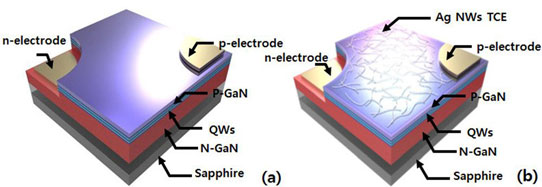Researchers in Korea have used spin-coated silver nanowires (Ag NWs) to improve the performance of indium gallium nitride light-emitting diodes (InGaN LEDs) [Gyu-Jae Jeong et al, Appl. Phys. Lett., vol106, p031118, 2015]. The team based at Korea Polytechnic University and Chonbuk National University believes that the improvements were due to better current spreading and thermal dissipation via the Ag NWs.
The spin-coating process could be an alternative to transparent conducting electrode (TCE) structures using expensive indium tin oxide (ITO) or more complex techniques such as graphene deposition on metal foil and transfer to LEDs. Although Ag NWs potentially suffer from long-term stability/degradation problems, these could be overcome with suitable encapsulation and packaging.
The researchers say that before their work "there have been no reports detailing the use of only Ag NWs in GaN-based LEDs as TCEs, with the exception of graphene/Ag NW hybrid films."
The InGaN heterostructures were grown on sapphire by metal-organic chemical vapor deposition (MOCVD). The LED material consisted of GaN buffer (2μm) and n-contact (3μm), 5-period In0.15Ga0.85N wells in GaN barriers, and GaN p-contact (0.1μm).
The epitaxial material was fabricated into 'ultra-large-size' 5mmx5mm mesa-structure LEDs (Figure 1). Conventional mesa-LEDs typically measure on the order of 1mmx1mm. The electrodes consisted of indium/tin.

Figure 1: Schematics of (a) conventional InGaN LED and (b) LED with Ag NWs as a TCE.
The silver nanowires were spin-coated for 40 seconds at 800 rotations per minute from a suspension supplied by Korean company Nanopyxis Inc. The nanowire source solution was sonicated for 6 minutes and shaken well before application. The deposited film was annealed for 1 minute at 100°C, giving a sheet resistance of 15Ω/square.
The researchers report that the coating process resulted in networks of randomly oriented Ag NWs with less than 50nm height variation – "sufficiently planar to form a p-type electrode in LEDs". The average NW diameter was 25nm. The lengths were of the order of tens of microns.
The open regions without NWs constituted about 84% of the surface. The optical transmittance of LED material with Ag NWs was about 6% less than without. However, photoluminescence was decreased about 32.5% by having NWs.
The researchers describe the electroluminescence emission as 'strong' in the blue region around 460nm with and without Ag NW contact layers. The peak at 20mA was at 457.8nm with Ag NWs and at 452.7nm without Ag NWs. Increasing the current injection between 10mA and 100mA led to a large shift in wavelength of 3.5nm for the LED without Ag NWs. Over the same range, the LED with Ag NWs shifted only 0.3nm. The more stable behavior of the device with Ag NWs was attributed to better current spreading leading to a decrease in the effective current density through the device.
The researchers comment: "The band-filling effect of LED without Ag NWs appeared to be dominant compared to LED with Ag NWs due to decreased carrier density, resulting in the longer emission wavelength of LED with Ag NWs than LED without Ag NWs. Moreover, at increasing injection current, this also likely contributed to the lower blue-shift of LED with Ag NWs than LED without Ag NWs."
The spectral line was also narrower for the LED with Ag NWs – around 15nm full-width at half maximum (FWHM), compared with ~20nm for the LED without current spreading. Although the FWHM increased in both devices at higher currents, the ~5nm difference was maintained. The researchers attributed the difference to the lower junction temperature (46.8°C at 50mA, compared with 70.5°C) in the device with Ag NWs.
"We surmised that the narrower FWHMs of the EL spectra originated from a decreasing thermal heating effect due to improved heat dissipation afforded by the Ag NWs," the researchers write.
Figure 2: Light output power (a), pulse/continuous wave (cw) EL intensity ratio (b), and relative EQE (c) of GaN-based LEDs without/with Ag NWs as a function of injection current. Current-voltage characteristic (d) of LEDs with/without Ag NWs.
At low injection currents the LED without Ag NW current spreading emitted more intense light, but above 45mA the device with Ag NWs performed increasingly better (Figure 2). Self-heating effects also adversely affected the light output power of the LED without Ag NWs more than for the device with Ag NWs. The team comments: "Because Ag NWs were effective at dissipating the thermal heat from LEDs, the cw EL intensity of LED without Ag NWs was drastically decreased under high injection current region (>30mA), leading to an increase in the pulse-to-cw EL intensity ratio."
The external quantum efficiency (EQE) of the LED without Ag NWs peaked at a very low current, while the efficiency increased over the range up to 100mA for the device with Ag NWs. The Ag NWs also reduced the turn-on voltage of the diode (2.72V versus 3.22V), also contributing to improved efficiency. Below turn-on the Ag NW LED showed a higher series resistance, indicating problems with surface currents. However, above turn-on the series resistance was lower for the Ag NW LED.





